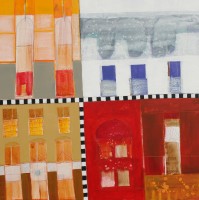 Iranian born Masoumeh’s work exudes colour and a strong sense of design. Her observations of the patterns and forms found in Middle Eastern architecture are given a new life as she takes liberties with scale and detail. The juxtaposition of varied elements in hues sometimes vivid sometimes subtle have an element of pageantry, standard bearers for a modern age. The fact that she has received no formal training enhances her works unique sense of fun youth and optimism. Masoumeh works alongside her husband Morteza Darehbaghi in Tehran where as a couple they are a pivotal part of Iran’s cultural community.
Iranian born Masoumeh’s work exudes colour and a strong sense of design. Her observations of the patterns and forms found in Middle Eastern architecture are given a new life as she takes liberties with scale and detail. The juxtaposition of varied elements in hues sometimes vivid sometimes subtle have an element of pageantry, standard bearers for a modern age. The fact that she has received no formal training enhances her works unique sense of fun youth and optimism. Masoumeh works alongside her husband Morteza Darehbaghi in Tehran where as a couple they are a pivotal part of Iran’s cultural community.
Masoumeh Abiri
Abdallah Akar
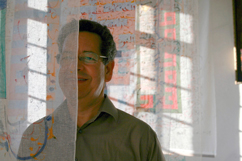 Abdallah Akar was born in Tunisia. He arrived in France in the late 1960’s to study Science at Paris V11 University but
Abdallah Akar was born in Tunisia. He arrived in France in the late 1960’s to study Science at Paris V11 University but
it was after meeting Iraki Ghani Alain in 1980 which cemented his passion for calligraphy.
In 1986, he had his first public exhibition of contemporary works. In subsequent years he has held numerous solo
and group exhibitions, lectures and courses. During the early 2000s, he completed an Installation: 16 textiles richly
decorated with calligraphy, a tribute to the Pre-Islamic poetry, followed in 2007 by a publication of Poèmes Suspendus
(Muallaq’at) edited in both languages, French and Arabic.
Abdallah Akar is always searching for a renewed rendition of the calligraphic language, exploring mediums such as
fabric, canvas, wood and even glass. He shows his work extensively in Europe and is a well known artist on the Middle
Eastern contemporary art scene.
Peter Collis
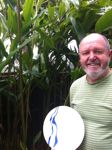 New Zealander Peter Collis has worked with clay nearly all of his life. The main focus to his work has been the handling of shape and surface. He creates pure form vessels, which he then treats in a wide range of methods. Crackle glazes, textured engobes, rich colour, finish the surface to complement the form.
New Zealander Peter Collis has worked with clay nearly all of his life. The main focus to his work has been the handling of shape and surface. He creates pure form vessels, which he then treats in a wide range of methods. Crackle glazes, textured engobes, rich colour, finish the surface to complement the form.
The predictability and ubiquity of his forms and surfaces perhaps led to the grant application to develop bone china,. It’s a challenging medium. Bone china is usually cast and his moulds were of a scale beyond what is typically seen for this body formulation, even by industry, the customary producer in this material originally developed to replicate porcelain.
Collis is a highly skilled thrower and a leader in technical aspects – he makes his own luster glazes, formulates clay bodies for particular purposes and adjusts a glaze to give him precisely what he requires in an eyelash drop. He is acknowledged as bone china’s master practicioner. The predictability and ubiquity of his forms and surfaces led to a recent grant application to develop bone china,. It’s a challenging medium. Bone china is usually cast and his moulds were of a scale beyond what is typically seen for this body formulation.
Peter Collis is a superb maker of the formalist pot, few can match his abilities and sheer application of years of hard-won knowledge,
A highly respected potter, Peter exhibits internationally and is represented in collections around the world.
Linda Styles
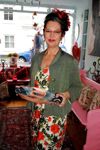 Linda is a London born but Cornwall based potter who exhibits widely around the UK and beyond. She came to clay relatively late having led a ‘colourful’ life, making her debut appearances as an undergraduate at the Tate Gallery in St. Ives (1994), moving onto Ceramic Contempories 2, at the V&A Museum, London (1995). She has work held in private and public collections, including the Gregg Museum of Folk Art, North Carolina, USA (2007). Sir Terance Conran commisioned her to design and make a range of breakfast tableware for Conran. Linda has maintained an intense academic profile for many years, during which time she was a visiting lecturer in Contemporary Crafts, Higher Education Course manager, curator and researcher at the Combined University of Cornwall and has directed Arts Council, Heritage Lottery and EU funded public art projects at Falmouth’s Municipal Gallery (2007-08).
Linda is a London born but Cornwall based potter who exhibits widely around the UK and beyond. She came to clay relatively late having led a ‘colourful’ life, making her debut appearances as an undergraduate at the Tate Gallery in St. Ives (1994), moving onto Ceramic Contempories 2, at the V&A Museum, London (1995). She has work held in private and public collections, including the Gregg Museum of Folk Art, North Carolina, USA (2007). Sir Terance Conran commisioned her to design and make a range of breakfast tableware for Conran. Linda has maintained an intense academic profile for many years, during which time she was a visiting lecturer in Contemporary Crafts, Higher Education Course manager, curator and researcher at the Combined University of Cornwall and has directed Arts Council, Heritage Lottery and EU funded public art projects at Falmouth’s Municipal Gallery (2007-08).
Since 2009 Linda has devoted herself totally to being a creative practitioner.
Jonathan Andersson
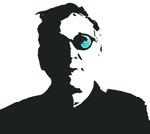 Jonathan was born into a family of glassmakers, he remembers visiting his father at Whitefriars factory, where he spent Saturdays helping out. He also recalls visiting his glassmaking Grandfather in both Denmark and Sweden. Beyond that birth and death certificates certify that glass has been in his family for 7 generations.
Jonathan was born into a family of glassmakers, he remembers visiting his father at Whitefriars factory, where he spent Saturdays helping out. He also recalls visiting his glassmaking Grandfather in both Denmark and Sweden. Beyond that birth and death certificates certify that glass has been in his family for 7 generations.
It is unsurprising then that to Jonothan glass is not simply a material , it is an integral part of his identity.
“Technically speaking glass is man’s first synthesized material, that is, its not found in nature. Of course we don’t often think about this and lets face it , most of us take glass pretty much for granted. Its the stuff we look through to keep the weather out. Or it’s the thing used to dispense drinks in, despite its fragility. However the qualities of glass and its history can be fascinating. I’ve learnt a lot about it but mainly I’m interested in its use as an artistic medium. Ever since I can remember I have had a desire , perhaps a need to make things happen. I’ve heard it called the “joie de faire”, the joy of making. There is something very primeval, very basic about taking very little and making something . Creating some-thing from no-thing. Or taking something which is less than nothing, some waste, some junk and making something beautiful, is a thing of wonder.”
Jonathan Middlemiss
 Jonathan is a ceramic artist specializing in finely made individual work. Despite its obviously contemporary form Jon is not greatly influenced by many contemporary ceramics genres but finds his inspiration in ancient history and spiritual practices of indigenous people around the world. The beautiful ceremonial work of the Anasazi in the Arizona desert combining creation myths and ritual function; early Christian icons; the ancient rock carvings and Bradshaw paintings by the people in the Kimberly area of Australia where a sophisticated shamanic culture thrived long before the aboriginals; the glassware of the Persian Empire; the tiles on the great facades of Samarkand; traditional Tibetan thankas. All speak to him with an old voice that is he feels is worth listening to.
Jonathan is a ceramic artist specializing in finely made individual work. Despite its obviously contemporary form Jon is not greatly influenced by many contemporary ceramics genres but finds his inspiration in ancient history and spiritual practices of indigenous people around the world. The beautiful ceremonial work of the Anasazi in the Arizona desert combining creation myths and ritual function; early Christian icons; the ancient rock carvings and Bradshaw paintings by the people in the Kimberly area of Australia where a sophisticated shamanic culture thrived long before the aboriginals; the glassware of the Persian Empire; the tiles on the great facades of Samarkand; traditional Tibetan thankas. All speak to him with an old voice that is he feels is worth listening to.
Subject to many international awards and commendations, his ceramic work is in public collections and museums around the world. Over a career of 40 years he has had many solo exhibitions in Britain, Germany, France, Holland, Belgium, Italy, Switzerland, the Middle East, America, Taiwan, Japan, Korea and New Zealand and has been featured in magazines, catalogues, dictionaries and other books.
Gold Medal -13th Biennale, Vallauris (F)1992.
Silver Medal – Kutani International Ceramics Competition (J)
1997 Honourable Mentions – Mino Triennale, Zagreb Triennale.
Member of International Academy of Ceramics – Prague 1994
Collections include Keramion, Kestner, Taipai and Cologne museums.
View Jonathan Middlemiss Portfolio,
Anne Hudson
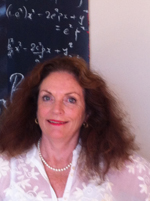 One of Anne’s favourite references is from Rose Slivka who states that the object is the poet. Anne firmly believes that a good object can sing, speak or give rise to narrative, ideas and concepts. The vessel is an abstract form in that it is a skin for nothing with a limitless potential to express meaning. Vessels are an integral part of our existence from womb, breast, cup to coffin and as such need our respect and reverence.
One of Anne’s favourite references is from Rose Slivka who states that the object is the poet. Anne firmly believes that a good object can sing, speak or give rise to narrative, ideas and concepts. The vessel is an abstract form in that it is a skin for nothing with a limitless potential to express meaning. Vessels are an integral part of our existence from womb, breast, cup to coffin and as such need our respect and reverence.
For this exhibition Anne has made three bodies of work:
Precious Earth: A visit to Antarctica made me aware of not only the awesome beauty but also the vulnerability of our planet. These vessels are made from porcelain, itself a precious material that reflects that fragility. The blue exterior glaze contrasts beautifully with the stark white and purity of the interior with the broken edge offering the horizon of an abstract landscape.
Rare Earth: This group of vessels has been thrown on the wheel using porcelain and then altered to give the static shape a sense of movement. The glaze has been coloured using rare earth elements that allow for the beautiful translucent pastels on these vessels. The elements have the fascinating names of erbium creating the pink, neodymium that produce violet and praseodymium which produce a citrus colour. When she make these bowls she is reminded that like those basic elements we are just star dust combined together to create beauty.
Memory Traces: This group of vessels relates to her pleasant memories of life in Dubai. The inserted screen printed patterns are of Arabic origin and remind her of many visits to The Majlis Gallery. The vessels have been thrown on the wheel in porcelain, then cut and the screen printed sections added. When completed the disturbed forms are reminiscent of the edge of a sand dune or the sail of a dhow. She feels fortunate to have travelled a great deal as all experiences add to our aesthetic sense and its expression.
View Anne Hudson Portfolio
Karel Zijlstra
Other human beings have always been on this world; this fact intrigued Karel Zijlstra since his childhood. In thousands of years men and women developed from bestial creatures to spiritual human beings.
Lack of specific knowledge made them believe in gods and miracles; life was explained and made bearable by storytelling. People joined in secret , associations searching the truth behind the harsh reality, preached by king and clergy.
Human evolution is the leading motive in Zijlistra’s work.
He was inspired by the Celts who came from eastern Europe through Holland, Scandanavia and England to Ireland. Like the upright Celtic dancer, Zijlistra’s statues reach out for elevation and spiritualization. His figures show no feet, they rize out of the misty Irish land like thin Gods. Their spirituality makes them almost unassailable.
These slender, introverted figures are often compared with Masai warriors or Egyptian gods. Rightly, according to the artist. Because his quest for origin, genesis and future of mankind is universal and embraces all people and all cultures.
Karel Zijlistra studied at the Academy of Industrial Design in Eindhoven. Since 1989 he applied himself completely to sculpting. In this period he discovered Celtic and mediaeval literature. Till today the King Arthur legends, the Holy Grail and Percival and the Irish myths and legends inspire his seemingly weightless bronze figures.
Zijlistra’s bronzes are modelled in wax and then cast in bronze in the lost wax method (cire- perdue).
Exhibitions in: Holland, Belgium, Germany, France, Spain, Portugal, Italy, Switzerland, Russia and USA.
View Karel Zijlstra Portfolio